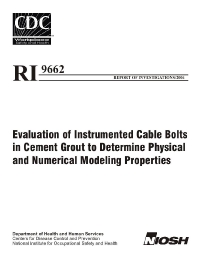 |
Whereas many researchers and mine engineers have conducted tests on cable bolts using various grouts, water:cement ratios, and physical modifications of the cable to determine the load-carrying characteristics of a bolt, few studies have been conducted on cable bolts fitted with internal instruments. Those studies that have been done have concentrated on cable response averaged over significant (6.1 m) cable lengths. Researchers at the Spokane Research Laboratory (SRL) of the National Institute for Occupational Safety and Health in Spokane, W A, are investigating the physical properties of cable bolts by replacing the conventional king wire with a modified king wire on which strain gauges have been installed. A numerical analysis was performed to match laboratory results. Loads calculated by the model were then compared to loads measured in the laboratory on 1.83-m-long cables grouted into two 0.91-m-long pull-tube assemblies. Load along the cable was monitored with 20 strain gauges installed along the length of the cable. This paper documents test results on these modified cable bolts. The instrumented cable bolt provided reproducible point measurements of cable load as opposed to load measurements averaged over long cable lengths. Such point measurements can assist in interpreting the influence of cable confinement, grout quality, rock mass stiffness, and other factors. The instrumented cable bolt is a practical field and research tool because it can predict point loading along the cable. The instrument has been successfully field tested at FMC's Granger Mine, Granger, WY; the Meikle Mine, Carlin, NY; the Stillwater Mine, Nye, MT; and the Getchell Mine, Golconda, NY. By monitoring load and displacement of the rock mass using these instrumented bolts, more-effective ground support can be selected and installed, which will lead to safer working conditions for miners.
| Author(s): | Martin-LA, Milne-D, Ruest-M, Pakalnis-R |
| Reference: | U.S. Department of Health and Human Services, Public Health Service, Centers for Disease Control and Prevention, National Institute for Occupational Safety and Health, DHHS (NIOSH) Publication No. 2004-140, Report of Investigations 9662, 2004 Apr :1-14 |
2004-140 (PDF, 615 KB)